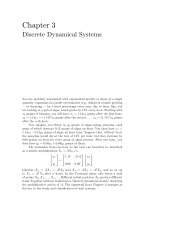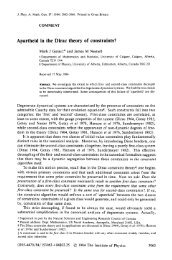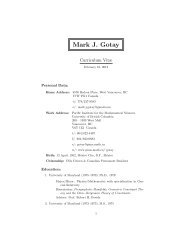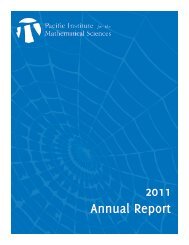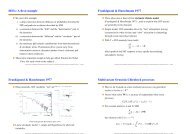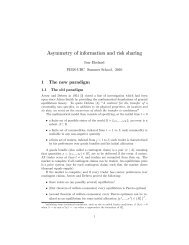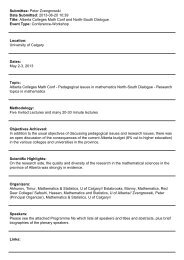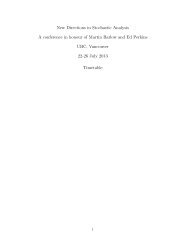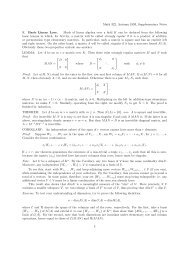39 PRIMA 2013 AbstractsAlexander MolevUniversity of Sydney, Australiaalexander.molev@sydney.edu.auFor each simple Lie algebra g the vacuum module overthe corresponding affine Kac-Moody algebra has a vertexalgebra structure. For each Lie algebra g of classicaltype, we use explicit gener<strong>at</strong>ors of the center of this vertexalgebra to produce explicit constructions of maximalcommut<strong>at</strong>ive subalgebras of the universal enveloping algebrasU(g).Cluster algebras and singular supports of perversesheavesHiraku NakajimaKyoto University, Japannakajima@kurims.kyoto-u.ac.jpWe propose an approach to Geiss-Leclerc-Schroer’s conjectureon the cluster algebra structure on the coordin<strong>at</strong>ering of a unipotent subgroup and the dual canonical base.It is based on singular supports of perverse sheaves onthe space of represent<strong>at</strong>ions of a quiver, which give thecanonical base.On orbits in double flag varieties for symmetricpairsHiroyuki OchiaiKyushu University, Japanochiai@imi.kyushu-u.ac.jpLet G be a connected, simply connected semisimple algebraicgroup over the complex number field, and let K bethe fixed point subgroup of an involutive automorphism ofG so th<strong>at</strong> (G, K) is a symmetric pair. We take parabolicsubgroups P of G and Q of K respectively and considerthe product of partial flag varieties G/P and K/Q withdiagonal K-action, which we call a double flag variety fora symmetric pair. It is said to be of finite type if thereare only finitely many K-orbits on it. In this paper, wegive a parameteriz<strong>at</strong>ion of K-orbits on G/P × K/Q interms of quotient spaces of unipotent groups without assumingthe finiteness of orbits. As a result, we get severaluseful criteria for the finiteness of orbits. If one ofP ⊂ G or Q ⊂ K is a Borel subgroup, the finiteness of orbitsis closely rel<strong>at</strong>ed to spherical actions. In such cases,the criteria enable us to obtain a complete classific<strong>at</strong>ionof double flag varieties of finite type. As a consequence,we obtain classific<strong>at</strong>ions of K-spherical flag varieties G/Pand G-spherical homogeneous spaces G/Q.Elementary subalgebras of modular Lie algebrasJulia PevtsovaUniversity of Washington, USAjulia@m<strong>at</strong>h.washington.eduLet g be a p-Lie algebra. We call a subalgebra E of gelementary of rank r if it is an abelian Lie algebra withtrivial p-restriction of dimension r. For a fixed r we considera projective variety E(r, g) th<strong>at</strong> parameterizes allelementary subalgebras of g of rank r. This variety is an<strong>at</strong>ural generaliz<strong>at</strong>ion of the rank variety introduced byCarlson for elementary abelian p-groups and the supportvariety for Lie algebras of Friedlander and Parshall.We’ll identify this projective variety in various classicalcases. We’ll also show how represent<strong>at</strong>ions of g with specialproperties lead to constructions of families of vectorbundles on E(r, g), thereby extending the study of “modulesof constant Jordan type" and their geometric applic<strong>at</strong>ionsto this more general context.Support varieties for reductive groupsPaul SobajeUniversity of Melbourne, Australiapaul.sobaje@unimelb.edu.auLet G be a reductive algebraic group over an algebraicallyclosed field of characteristic p, and denote by G (r) itsr-th Frobenius kernel. Each G (r) -module M has associ<strong>at</strong>edto it a cohomological support variety, which canbe shown in most cases to be homeomorphic to a closedsubset of the variety of commuting r-tuples of p-nilpotentelements in the Lie algebra of G. We will give some ofthe details about this homeomorphism, and also discussexplicit comput<strong>at</strong>ions in the case th<strong>at</strong> M is the restrictionof either a simple G-module or a Weyl module.Decomposition numbers for the symmetricgroups and Schur algebrasKai Meng TanN<strong>at</strong>ional University of Singapore, Singaporetankm@nus.edu.sgThe complete determin<strong>at</strong>ion of the decomposition numbersfor the symmetric groups and Schur algebras in positivecharacteristic p is a famous open problem; a completesolution of which does not seem to be forthcomingin the near future. In this talk, we present our recentresults which provide closed formulas for the decompositionnumber d λµ when the partition λ is obtained fromµ by moving some nodes whose p-residues are pairwisenon-adjacent.Hodge theory and represent<strong>at</strong>ion theoryKari VilonenNorthwestern University, USAvilonen@northwestern.eduI will explain how Hodge theory can be used in the represent<strong>at</strong>iontheory of real groups to <strong>at</strong>tack the problem ofthe unitary dual.Globalizing crystal basis for quantum superalgebrasWeiqiang WangUniversity of Virginia, USAww9c@virginia.eduCanonical basis (or global crystal basis) for quantumgroups and their integrable modules was introduced anddeveloped by Lusztig and subsequently by Kashiwara.We will present a construction for the first time, motiv<strong>at</strong>edby c<strong>at</strong>egorific<strong>at</strong>ion, of canonical basis for a classof quantum superalgebras and their integrable modules.This is joint work with Sean Clark and David Hill.Special Session 20Singularities in Geometry and TopologyThe topology of real suspension singularitiesof type fḡ + z nHaydée Aguilar CabreraN<strong>at</strong>ional Autonomous University of Mexico, Mexicolangeh@gmail.comIn this talk we present some results on the topology ofthe family of real analytic germs F : (C 3 , 0) → (C, 0)with isol<strong>at</strong>ed critical point <strong>at</strong> 0, given by F (x, y, z) =f(x, y)g(x, y)+z r , where f and g are holomorphic,r ∈ Z+
40 PRIMA 2013 Abstractsand r ≥ 2. We describe the link L F as a graph manifoldusing its n<strong>at</strong>ural open book decomposition, rel<strong>at</strong>ed tothe Milnor fibr<strong>at</strong>ion of the map-germ fḡ and the descriptionof its monodromy as a quasi-periodic diffeomorphismthrough its Nielsen invariants. Furthermore, such a germF gives rise to a Milnor fibr<strong>at</strong>ionF : S |F | 5 \L F → S 1 .We present a join theorem, which allows us to describethe homotopy type of the Milnor fibr<strong>at</strong>ion of F and weshow some cases where the open book decomposition ofS 5 given by the Milnor fibr<strong>at</strong>ion of F cannot come fromthe Milnor fibr<strong>at</strong>ion of a complex singularity in C 3 .On Griffiths numbers for higher dimensionalisol<strong>at</strong>ed singularitiesRong DuEast China Normal University, Chinardu@m<strong>at</strong>h.ecnu.edu.cnWe will discuss some numerical invariants for isol<strong>at</strong>ed singularitiesand their rel<strong>at</strong>ions. In particular, we will showth<strong>at</strong> S. Yau’s conjecture on inequalities for (n−1)-th Griffithsnumber and (n − 1)-th Hironaka number holds forirregular singularities and it is not true in general.Equisingularity and integral closure of idealsand modules: two partners in a danceTerence GaffneyNortheastern University, USAt.gaffney@neu.eduA family of sets or mappings is equisingular if the singularitiesof the family are similar, in a well defined sensedepending on the equisingularity condition. The theory ofintegral closure is an important tool for studying equisingularityconditions. It provides invariants which describethe condition, and provide means of proving the conditionshold for a family. In this talk we will quickly repriseresults for Whitney equisingularity, then discuss how toapply the same ideas to construct an infinitesimal theoryof bi-Lipschitz equivalence.Improved bounds on the ranks of the Milnorfiber cohomologyDavid B. MasseyNortheastern University, USAd.massey@neu.eduAs we showed 25 years ago, the Lê numbers provide upperbounds on the ranks of the cohomology of the Milnorfiber of a function with a critical locus of arbitrary dimension.Our new results deal with when the maps in the Lêcomplex can be zero, and so give us improved bounds onthe Milnor fiber cohomology. Our results in the classicalcase follow from more general results on the vanishingcycles of perverse sheaves.Characteristic classes of singular toric varietiesLaurentiu MaximUniversity of Wisconsin-Madison, USAmaxim@m<strong>at</strong>h.wisc.eduWe discuss the comput<strong>at</strong>ion of the homology Hirzebruchcharacteristic classes of (possibly singular) toric varieties.We present two different perspectives for the comput<strong>at</strong>ionof these characteristic classes. First, we take advantage ofthe torus-orbit decomposition and the motivic propertiesof the homology Hirzebruch classes to express the l<strong>at</strong>terin terms of the (dual) Todd classes of closures of orbits.The obtained formula is then applied to weighted l<strong>at</strong>ticepoint counting in l<strong>at</strong>tice polytopes. Secondly, in the caseof simplicial toric varieties, we make use of the Lefschetz-Riemann-Roch theorem in the context of the geometricquotient description of such varieties. In this setting, wedefine mock Hirzebruch classes of simplicial toric varietiesand investig<strong>at</strong>e the difference between the (actual) homologyHirzebruch class and the mock Hirzebruch class. Weshow th<strong>at</strong> this difference is localized on the singular locus,and we obtain a formula for it in which the contributionof each singular cone is identified explicitly. This is jointwork with Jörg Schürmann.On the topology of real analytic mapsJosé Luis Cisneros MolinaN<strong>at</strong>ional Autonomous University of Mexico, Mexicojlcm@m<strong>at</strong>cuer.unam.mxJoint work with Nivaldo G. Grulha Jr. and José Seade.In this talk we present some recent results on the topologyof real analytic maps. Every real analytic map germf : R n → R p , p ≥ 1, with arbitrary critical set, has aMilnor-Lê type fibr<strong>at</strong>ion. Now assume also th<strong>at</strong> f hasthe Thom a f -property, and its zero-locus has positive dimension.Also consider another real analytic map germg : R n → R k with an isol<strong>at</strong>ed critical point <strong>at</strong> the origin.We have Milnor-Lê type fibr<strong>at</strong>ions for f and for(f, g): R n → R p+k , and we prove for these the analogousof the classical Lê-Greuel formula, expressing the differenceof the Euler characteristics of the fibers F f and F f,gin terms of an invariant associ<strong>at</strong>ed to these maps.Intersection theory on mixed curvesMutsuo OkaTokyo University of Science, Japanoka@rs.kagu.tus.ac.jpWe consider two mixed curve C, C ′ ⊂ C 2 which are definedby mixed functions of two variables Z = (z 1 , z 2 ). Wehave shown in our previu paper th<strong>at</strong> they have canonicalorient<strong>at</strong>ions. If C and C ′ are smooth and intersecttransversely <strong>at</strong> P , the intersection number I top(C, C ′ ; P )is topologically defined. We will generalize this definitionto the case when the intersection is not necessarilytransversal or either C or C ′ may be singular <strong>at</strong> P usingthe defining mixed polynomials.Newton-Puiseux analysisLaurentiu PaunescuThe University of Sydney, Australialaurent@m<strong>at</strong>hs.usyd.edu.auComplex analysis is extended to the Newton-Puiseuxfield. We give analogues of several clasic results and, asa corollary, a short proof of the Kuo-Lu theorem.Singularities of several geometric objects rel<strong>at</strong>edto null curves in Minkowski 3-spaceDonghe PeiNortheast Normal University, Chinapeidh340@nenu.edu.cnIn this article, we investig<strong>at</strong>e the singularities of nullDarboux developables, Gaussian surfaces and pseudosphericalDarboux Images associ<strong>at</strong>ed with a null Cartancurve in Minkowski 3−space. This is a joint work withZhi-Gang Wang.Broken Lefschetz fibr<strong>at</strong>ions and their moves
- Page 2 and 3:
1PRIMA 2013-Table of ContentsTable
- Page 4 and 5:
3PRIMA 2013-OrganizationOrganizatio
- Page 6 and 7:
5PRIMA 2013-OrganizationYoshikazu G
- Page 8 and 9:
7PRIMA 2013-Useful InformationUsefu
- Page 10 and 11:
9PRIMA 2013-Useful InformationTaxi:
- Page 12 and 13:
11PRIMA 2013-Useful Informationmath
- Page 14 and 15:
13PRIMA 2013 Program-Schedule-at-a-
- Page 16 and 17:
15PRIMA 2013 Program-Monday, June 2
- Page 18 and 19:
17PRIMA 2013 Program-Monday, June 2
- Page 20 and 21:
19PRIMA 2013 Program-Monday, June 2
- Page 22 and 23:
21PRIMA 2013 Program-Monday, June 2
- Page 24 and 25:
23PRIMA 2013 Program-Tuesday, June
- Page 26 and 27:
25PRIMA 2013 Program-Tuesday, June
- Page 29 and 30:
28PRIMA 2013 Program-Tuesday, June
- Page 31 and 32:
30PRIMA 2013 Program-Tuesday, June
- Page 33 and 34:
32PRIMA 2013 Program-Wednesday, Jun
- Page 35 and 36: 34PRIMA 2013 Program- Thursday, Jun
- Page 37 and 38: 36PRIMA 2013 Program- Thursday, Jun
- Page 39 and 40: 38PRIMA 2013 Program- Thursday, Jun
- Page 41 and 42: 40PRIMA 2013 Program- Thursday, Jun
- Page 43 and 44: 42PRIMA 2013 Program- Friday, June
- Page 45 and 46: 44PRIMA 2013 Program- Friday, June
- Page 48 and 49: 1 PRIMA 2013 AbstractsContents1 Pub
- Page 50 and 51: 3 PRIMA 2013 Abstractsof subfactors
- Page 52 and 53: 5 PRIMA 2013 AbstractsprocessesXu S
- Page 54 and 55: 7 PRIMA 2013 AbstractsIn this talk
- Page 56 and 57: 9 PRIMA 2013 Abstractsindependently
- Page 58 and 59: 11 PRIMA 2013 AbstractsEnumerating,
- Page 60 and 61: 13 PRIMA 2013 AbstractsRyuhei Uehar
- Page 62 and 63: 15 PRIMA 2013 AbstractsIn this talk
- Page 64 and 65: 17 PRIMA 2013 AbstractsSpecial Sess
- Page 66 and 67: 19 PRIMA 2013 Abstractscritical slo
- Page 68 and 69: 21 PRIMA 2013 AbstractsSpecial Sess
- Page 70 and 71: 23 PRIMA 2013 Abstractsstrictly awa
- Page 72 and 73: 25 PRIMA 2013 AbstractsPedram Hekma
- Page 74 and 75: 27 PRIMA 2013 Abstractsis well-know
- Page 76 and 77: 29 PRIMA 2013 Abstractssolid substr
- Page 78 and 79: 31 PRIMA 2013 AbstractsRapoport-Zin
- Page 80 and 81: 33 PRIMA 2013 Abstractssense. Our a
- Page 82 and 83: 35 PRIMA 2013 AbstractsIn an econom
- Page 84 and 85: 37 PRIMA 2013 AbstractsKyoto Univer
- Page 88 and 89: 41 PRIMA 2013 AbstractsOsamu SaekiK
- Page 90 and 91: 43 PRIMA 2013 Abstractsopen Delzant
- Page 92 and 93: 45 PRIMA 2013 AbstractsJian ZhouTsi
- Page 94 and 95: 47 PRIMA 2013 AbstractsJiaqun WeiNa
- Page 96 and 97: 49 PRIMA 2013 Abstractsthe end of 2
- Page 98 and 99: 51 PRIMA 2013 AbstractsJongyook Par
- Page 100 and 101: 53 PRIMA 2013 AbstractsPancyclicity
- Page 102 and 103: 55 PRIMA 2013 AbstractsEfficient nu
- Page 104 and 105: 57 PRIMA 2013 Abstractsand fountain
- Page 106: 59 PRIMA 2013 Abstractsformula esti



